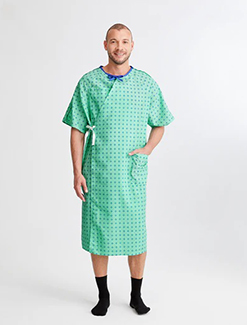There is no consensus about who invented the hospital gown, although a common joke among patients and medical staff is that his name was Seymour Butts. Actor Danny DeVito got to the bottom of the joke in a Christmas movie, spinning about to show off the gown’s cheeky features.
The humor serves as a coping mechanism: The traditional gown — fits like a drop cloth, pretty as a shower liner, promotes exhibitionism — engenders feelings from discomfort to contempt to resignation. When patients, doctors, and nurses were asked to share thoughts about the gowns, for a study published in Patient Experience Journal (PXJ) in 2020, their comments included:
- "Nightmare."
- "Flapping in the breeze."
- "One-size-fits-none."
- "Confusing."
- "Drab."
- "If I do that in the street, they’d arrest me."
“The gown causes so much distress to patients,” says Christy Lucas, MD, who led the PXJ study when she was a student at Penn State College of Medicine. Many health care providers she interviewed feel uncomfortable about the gowns as well.
A study published in 2021, led by four doctors at the Donald and Barbara Zucker School of Medicine at Hofstra/Northwell, in New York, made this blunt observation: “The traditional hospital gown is dehumanizing, anachronistic, and was designed for providers’ convenience.”
There are alternatives. Clothing designers have created hospital gowns that preserve patient dignity while giving medical staff necessary access to particular parts of the body, such as sites of surgical closings and tube insertions. The newer gowns offer openings down the side or front; wraparound styles that resemble robes; snap fastenings; pockets for medical and personal devices; and attractive colors.
Nevertheless, the single-size gown with the “tie-it-behind-your-back” challenge remains the norm. Designers and hospital staff attribute that to cost and organizational inertia. Lucas calls the patient gown “a necessary evil. But it doesn’t have to exist as it has for the past 100 years.”
Doctors and designers talked about why the gown persists, and efforts to redesign it.
Function and feelings
As best as anyone can discern, the open-backed gown was invented about a century ago, initially for surgical patients. Its primary purposes — as explained in Exposing hospital gowns, a commentary in The Hospitalist by Lucas and Cheryl Dellasega, PhD, of the Penn State College of Medicine — were to access areas of the body while the patient was sedated and not ruin the patient’s clothes with bodily fluids.
More doctors came to see the gown as useful for other patients. Stephanie Bayer, senior director of patient experience at the Cleveland Clinic, notes that when medical staff need to examine a patient, shirts and pants often inhibit their access to a port or surgical site, or to areas for taking routine measurements such as blood pressure. “We need to check on our patients, and the gown makes that easier,” she says.
That’s why “Take off your clothes and put this on” has become a standard instruction to many inpatients, as well as to people undergoing exams in doctors’ offices and medical labs. The ritual is so customary that patients begrudgingly accept it; they understand the gown’s purpose and think they have no choice.
“From a patient’s perspective,” Bayer observes, “there are concerns about dignity, autonomy, and respect for the body.”
It’s not just the rear exposure that causes discomfort; it’s that all body parts are shielded only by a flimsy, loose-fitting piece of cloth as acquaintances (your doctor) and strangers (residents and scribes) look on.
There’s a fundamental psychological impact as well. In the PXJ study, one doctor said the gown “is a way of saying that, ‘While you’re here, you’re totally dependent upon everybody else.’” Another observed, “Right then and there you’ve become the patient. You’ve lost that control. They turn more into just a body than a person.”
Attempts at change
Designing an alternative gown that meets patient and caregiver priorities has proven complicated.
In 1999, fashion designer Cynthia Rowley created a gown and matching robe for Hackensack University Medical Center, in New Jersey. In 2010, the Cleveland Clinic hired a designer who created a “wrap design with a bold, graphic print.” In 2014, the Henry Ford Health System in Detroit teamed up with Carhartt, a seller of work wear, to make a robe they dubbed the Model G. In 2021, Miami fashion designer René Ruiz created gowns with specific features for patients at Jackson Memorial Hospital’s Miami Transplant Institute.
Only the Cleveland Clinic and Jackson Memorial say they use versions of those designs today. Care+Wear, a New York-based company that sells clothing for medical staff and patients, reports that its patient-friendly gowns, based on designs first conceived in 2017, are used by several Veterans Administration hospitals.
The challenge to create and sell an alternative is illustrated by Care+Wear’s experience. The company partnered with the Parsons School of Design to come up with a more dignified and comfortable patient gown. Parsons set up a class of 10 students, who worked in teams with input from patients, caregivers, other hospital staff, and established fashion designers. The students’ designs were manufactured and presented to the class and to invited observers (famed designer Donna Karan among them) for critiques and revisions.
Among the factors that the Parsons students and the designers for hospitals learned to take into account:
Closings — The long fabric laces on traditional gowns can be hard to tie, and they loosen easily. Velcro seems easier to attach and stay put. But hospitals wouldn’t accept Velcro because lots of things cling to it (picture lint), which can spread disease.
“It harbors microbes, so it causes infection issues,” says Care+Wear Founder and CEO Chaitenya Razdan, MBA.
Snaps also seem easier and more stable than fabric ties. Plastic snaps are less expensive than metal ones, but at Jackson Memorial, designer Ruiz was told that “the plastic would not be strong enough for the laundry.” Care+Wear started with metal snaps but found plastic snaps that are strong enough.
Speaking of laundry …
Laundry challenges — During washing and drying, a gown goes through rough tumbling and temperatures of 450 degrees Fahrenheit, Razdan learned. “Being able to survive the wash-and-dry process is important.”
Thus, one student’s idea to use fabric made of recycled milk got nixed. “Sounds amazing, but that doesn’t survive the laundry process,” Razdan says.
A related factor is how much it costs to wash and dry the gowns. Hospitals typically pay their outsourced laundry services by weight. A blend that includes cotton is softer than polyester, but cotton’s weight increases the laundering cost, Razdan notes. And cotton wrinkles more.
Pockets — Patients want pockets so they can keep some of their personal items (primarily cell phones) when walking around their rooms and hospital wards. Clinicians want pockets in the gowns to hold telemetry devices that collect and transmit patient data, such as vital signs, during those same strolls.
The Parsons students initially proposed two pockets — and “the hospital laundry people said, ‘Absolutely not,’” Razdan recalls. “They said people are going to forget things” in one of the pockets when they discard the gown as they leave the hospital, which puts a search-and-discovery burden on the staff.
At the Miami Transplant Institute, providing easy-to-use pockets for telemetry devices is a medical priority: The pockets make it easier for patients to get up and walk the ward, says Vice President Luke Preczewski. “The sooner and the more that patients walk around, the better” for their recovery, he adds.
In one of those details that seems small but means a lot, the traditional gown used by the institute featured a pocket in the front. The nurses said that “one of the big irritants for the patients was the way that dragged down the gown” as people walked, because of the weight of the device, Preczewski recalls.
Updated options
The newer designs have features to address patient concerns while meeting clinician needs.
Openings — Several of the gowns look like wraparound robes, with closings on the side or in the front. Some feature bathrobe-like ties or the standard cloth laces, while others close with snaps along the shoulders and down the sides.
Some hospitals offer openings geared toward the patient’s procedures. At the Cleveland Clinic, back-opening gowns are still available for patients whose procedures require that access. Bayer notes that her father was there for back surgery, “and he got a gown that opens in the back. There are options that we’ve had to develop, depending on the patient’s needs.”
The standard gown at the Cleveland Clinic now features a V-neck, Bayer says, which allows easier access to the neck area for clinicians and is more comfortable for a patient overall. “When you're twisting in the bed, it [the gown] is not caught around your neck,” she says.
At the Miami Transplant Institute, the gowns include slits that give staff easy access to tubing and electrical lines (for pacemakers, for instance) without needing to untie or unsnap larger areas of the gown, Ruiz says. Some Care+Wear gowns feature zippers for access to a medical port.

Sizes — The Cleveland Clinic offers four sizes of adult gowns, Bayer says. Care+Wear sells three. But that’s unusual. Stocking and tracking numerous sizes creates an administrative and purchasing burden, says Preczewski of the Miami Transplant Institute.
A note about child patients: There appear to be more size and design choices for children, including gowns based on TV and movie characters. For example, some hospitals offer gowns based on Disney characters.
Pockets — Care+Wear gowns come with one front pocket, so patients will have just one place to remember where they put their items before they leave. At the Miami Transplant Institute, the patient gowns feature two pockets on the inside: typically, one for a telemetry device, one for a drain that draws fluid from the surgical site. Ruiz says that balances the weight distribution for patients as they walk around during recovery.
Aesthetics — The gowns at some hospitals come in more colors, often that match the color scheme of the hospital or that show the hospital logo.
Materials — Manufacturers offer a mix, including cotton-polyester blends, which are soft, and all polyester, which is lighter and less prone to wrinkling.
Despite these options, most patients today are likely to be offered some version of the standard gown. Cost remains a big factor. Prices for standard gowns vary depending on such features as material and order volume; online listings start at about $3 to $4 each. Patient gowns at Care+Wear come in numerous varieties and can come close to the cost of a standard gown or be several times higher. The gowns and robes created in 1999 for Hackensack University Medical Center cost $6 to $12 each.
Lucas, now a clinical fellow in pediatric hematology/oncology at Dana-Farber/Boston Children’s Cancer and Blood Disorders Center, believes hospitals can address patients’ discomfort in several ways: by cutting back on the habit of using the standard gowns, because in many situations a patient’s loose clothing provides sufficient access; by letting patients know that, in some cases, the gowns are optional; and by pushing for simple redesigns that don’t cost much.
“It can be as simple as changing the color options or changing the fabric, changing the types of gowns you order,” Lucas says. “It’s so easy to make a meaningful impact, to make people feel better.”

